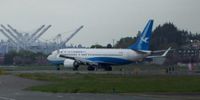In a dramatic escalation of trade tensions, Chinese airlines have begun sending Boeing aircraft back to the United States as a direct response to soaring tariffs imposed by the U.S. government. The tariffs, which have now reached an unprecedented 145%, are part of the ongoing trade war initiated by former President Donald Trump, aimed at curbing Chinese imports.
On April 19, 2025, a Boeing 737 Max, intended for Xiamen Airlines, made its way back to Seattle after a long journey that included refueling stops in Guam and Hawaii. This aircraft, which has a market value of approximately $55 million, was one of the first to return following China's directive to its airlines to halt further deliveries of Boeing jets. This decision was made after the tariffs rendered the cost of acquiring such planes prohibitively expensive, potentially exceeding $100 million due to the additional charges.
According to reports from Fox News and Reuters, the 737 Max was at Boeing's Zhoushan completion center in eastern China, where it awaited final assembly before delivery. The return of this aircraft signals a significant disruption in the aerospace industry, which has enjoyed decades of duty-free status for aircraft sales between the two nations.
China's retaliation against U.S. tariffs has included imposing a 125% tariff on American goods, further complicating the situation for Boeing, which has been a major exporter to China. In 2024 alone, the U.S. exported nearly $12 billion in aircraft and related components to China. This trade dynamic is crucial as Boeing has historically relied on Chinese orders to sustain its production levels.
As of now, reports indicate that at least three additional 737 Max 8 planes, which were being prepared for delivery to Chinese airlines, have also been recalled to the U.S. This includes another 737 Max that took off from Zhoushan on April 21, 2025, and is currently en route to Guam. The uncertainty surrounding these deliveries has left many airline executives contemplating deferring their orders rather than facing crippling tariffs.
The implications of this trade standoff extend beyond just Boeing. Analysts suggest that a prolonged halt in Chinese purchases could have detrimental effects on the Chinese aircraft manufacturer Comac, which is being positioned as a domestic alternative to Boeing and Airbus. The Chinese government has invested heavily in Comac, aiming to produce competitive commercial aircraft. However, the C919 model, which is seen as a competitor to Boeing's 737, relies on critical technology supplied by American companies, including GE Aerospace and Honeywell.
During a recent tour of Southeast Asia, Chinese President Xi Jinping was seen using a Boeing 747-8, underscoring the complex relationship between the two countries. Despite the mounting tensions, Boeing remains a significant player in the global aviation market, employing approximately 150,000 people in the U.S. and supporting an estimated 1.6 million jobs overall.
As the trade war intensifies, the uncertainty surrounding aircraft deliveries continues to grow. Airline executives have expressed concerns that shifting tariffs could leave many aircraft deliveries in limbo. With the aviation industry still recovering from the impacts of the COVID-19 pandemic, the stakes are high. Some airline CEOs have indicated they would prefer to delay deliveries rather than incur additional costs due to tariffs.
Malaysia Airlines has expressed interest in acquiring jets that may become available as a result of these trade tensions. The airline's parent company, Malaysia Aviation Group, is in discussions with Boeing about potentially securing delivery slots for the newly rejected aircraft. This presents a unique opportunity for Malaysia Airlines, which aims to expand its fleet significantly by 2030.
The current situation reflects a broader trend in international trade, where tariffs and trade barriers are increasingly being used as tools of economic policy. The aerospace industry, in particular, has been caught in the crossfire of these geopolitical tensions. With both sides imposing heavy tariffs, the future of Boeing's operations in China remains uncertain.
Despite the ongoing challenges, Boeing is looking to recover from an almost five-year import freeze on its 737 Max jets, which was triggered by safety concerns and previous trade disputes. The company has lost an estimated $51 billion in operating losses since 2018, making the stakes even higher in this latest round of trade negotiations.
As the situation develops, both U.S. and Chinese officials are under pressure to find a resolution that could restore the long-standing duty-free status that has benefited the aerospace industry for decades. The complexities of this trade war illustrate the intertwined nature of global economies and the potential ramifications of tariff policies on international business.
In summary, as Chinese airlines begin to return Boeing jets to the U.S. in response to escalating tariffs, the implications of this trade war extend far beyond the aviation industry. With both nations locked in a cycle of retaliatory measures, the future of aircraft deliveries and the broader economic relationship between the U.S. and China hangs in the balance.







